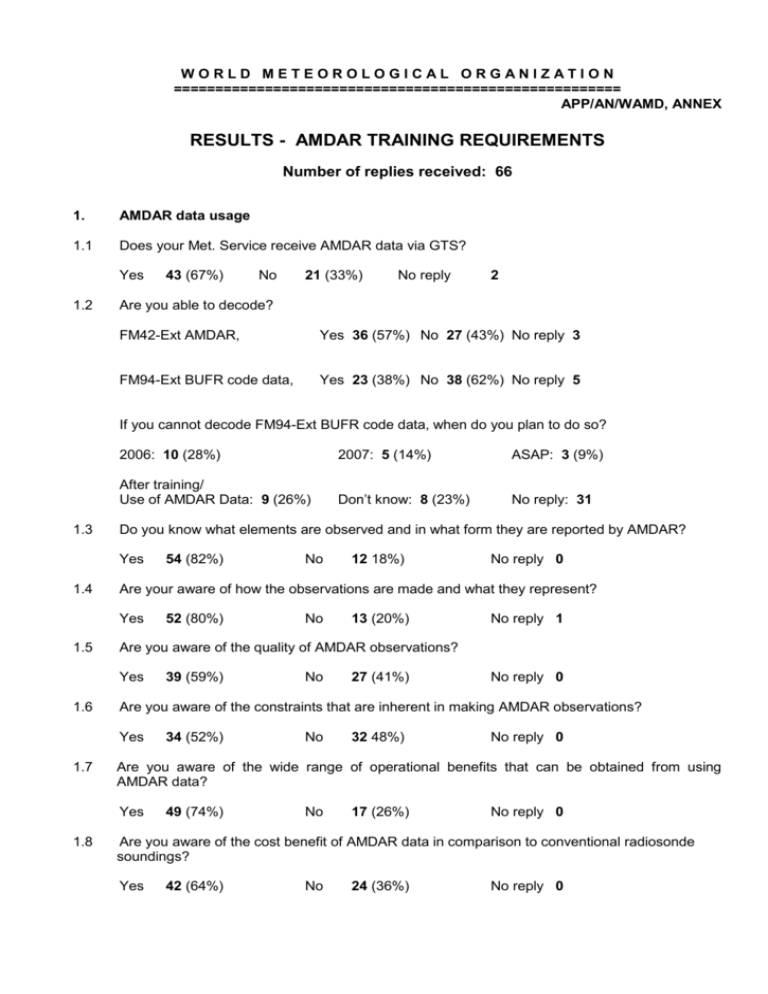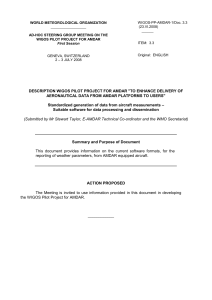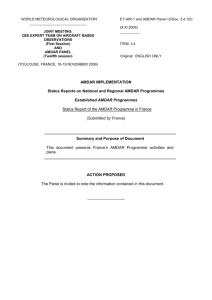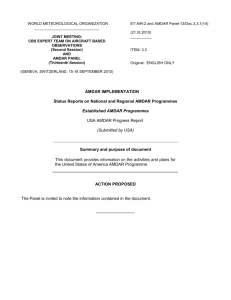Our ref
advertisement

WORLD METEOROLOGICAL ORGANIZATION ====================================================== APP/AN/WAMD, ANNEX RESULTS - AMDAR TRAINING REQUIREMENTS Number of replies received: 66 1. AMDAR data usage 1.1 Does your Met. Service receive AMDAR data via GTS? Yes 1.2 43 (67%) No 21 (33%) No reply 2 Are you able to decode? FM42-Ext AMDAR, Yes 36 (57%) No 27 (43%) No reply 3 FM94-Ext BUFR code data, Yes 23 (38%) No 38 (62%) No reply 5 If you cannot decode FM94-Ext BUFR code data, when do you plan to do so? 1.3 2006: 10 (28%) 2007: 5 (14%) ASAP: 3 (9%) After training/ Use of AMDAR Data: 9 (26%) Don’t know: 8 (23%) No reply: 31 Do you know what elements are observed and in what form they are reported by AMDAR? Yes 1.4 52 (80%) No 13 (20%) No reply 1 39 (59%) No 27 (41%) No reply 0 34 (52%) No 32 48%) No reply 0 Are you aware of the wide range of operational benefits that can be obtained from using AMDAR data? Yes 1.8 No reply 0 Are you aware of the constraints that are inherent in making AMDAR observations? Yes 1.7 12 18%) Are you aware of the quality of AMDAR observations? Yes 1.6 No Are your aware of how the observations are made and what they represent? Yes 1.5 54 (82%) 49 (74%) No 17 (26%) No reply 0 Are you aware of the cost benefit of AMDAR data in comparison to conventional radiosonde soundings? Yes 42 (64%) No 24 (36%) No reply 0 -21.9 Which kind of display system do you use for the presentation of the AMDAR data? Misc. systems In-house systems No system No reply 1.10 In which area of application do you use AMDAR data? a. b. c. d. 1.11 24 9 17 16 NWP Now-casting Climatology No reply 23 (57,5%) 28 (70%) 4 (10%) 26 Are you aware that AMDAR data can be accessed through the Internet? Yes 35 (54%) No 30 (46%) No reply 1 2. Familiarization and awareness of the availability and use of AMDAR data 2.1 Do you have a need for basic information on the availability of AMDAR Data, including: i. What it is and how it is obtained? Yes ii. 50 (77%) No 15 (23%) (No reply 1) 51 (79%) No 14 (21%) (No reply 1) 45 (69%) No 20 (31%) (No reply 1) Telecommunication and data distribution? Yes vi. (No reply 2) Data formats and codes? Yes v. 16 (25%) Constraints on its availability and coverage? Yes iv. No Data quality and reliability? Yes iii. 48 (75%) 48 (76%) No 15 (24%) (No reply 3) No 16 (25%) (No reply 2) Data management? Yes 48 (75%) -3vii. Data presentation tools and utilization? Yes 2.2 No 13 (20%) (No reply 2) Is there a need for training in your NMS on the use of AMDAR data for operational applications? (Please note that Meteorological services have used AMDAR data effectively to improve forecasts of aviation, marine, fire weather, agricultural and public weather forecasts. Many example applications are available.) Yes 2.3 51 (80%) 52 (79%) No 14 (21%) If YES, how soon do you require this training? Should it be made available in sections, so that portions might be available sooner, or would it be better to have an entire presentation at a later date? Entire presentation later 21 Training required urgently (2006) In sections 20 8 At a later stage 3 3. Training approaches 3.1 Is your service technically equipped to take part in web based computer aided learning programmes? Yes 3.2 53 (82%) 63 (95%) Unix 31 (47%) 35 (55%) No 29 (45%) (No reply 2) Does your Met Service make use of VL or other computer aided learning programmes in other areas of interest? Yes 3.5 (No reply 1) Are you aware of the concept of Virtual Laboratory (VL) for Education and Training in Satellite Meteorology? Yes 3.4 12 (18%) Do you use Windows or Unix based platforms? Windows 3.3 No 21 (32%) No 44 (68%) (No reply 1) What methods of training would best meet the needs of your organization? Computer-aided learning via Internet? Yes 36 (55%) No 10 (15%) (No reply 20) Computer aided learning via CD/DVD? Yes 43 (93%) No 7 (15%) (No reply 16) Training workshop/seminar? No 7 (11%) (No reply 7) Yes 52 (79%) -4- 3.6 In which language or languages should training be made available? English 54 3.7 3.9 Spanish 7 Russian 4 Arabic 4 Can you utilize existing training examples using English units of measure? Yes 3.8 French 11 46 (72%) No 18 (28%) (No reply 2) Do you use skew-T or Tephigrams for soundings? Skew-T 19 (29%) Others 16 (24%) Tephigram 36 (55%) If your Met Service currently uses AMDAR, do you have examples of AMDAR data use that would be useful to include in this training? No examples: No reply: 28 24 Various examples reported: - Altitude analysis - Impact study - Monitoring plots - Low level windshear detection - Hourly wind analysis and other observational data - Upper air charts - Moscow international airport - Wind and temperature profiles - Temperature inversions and possible windshear at airports - Aladin-Tunisia - Forecasting turbulences - Verification of numerical forecasts - Short-term forecasts. _______











